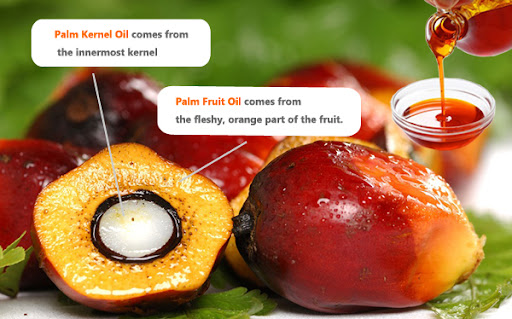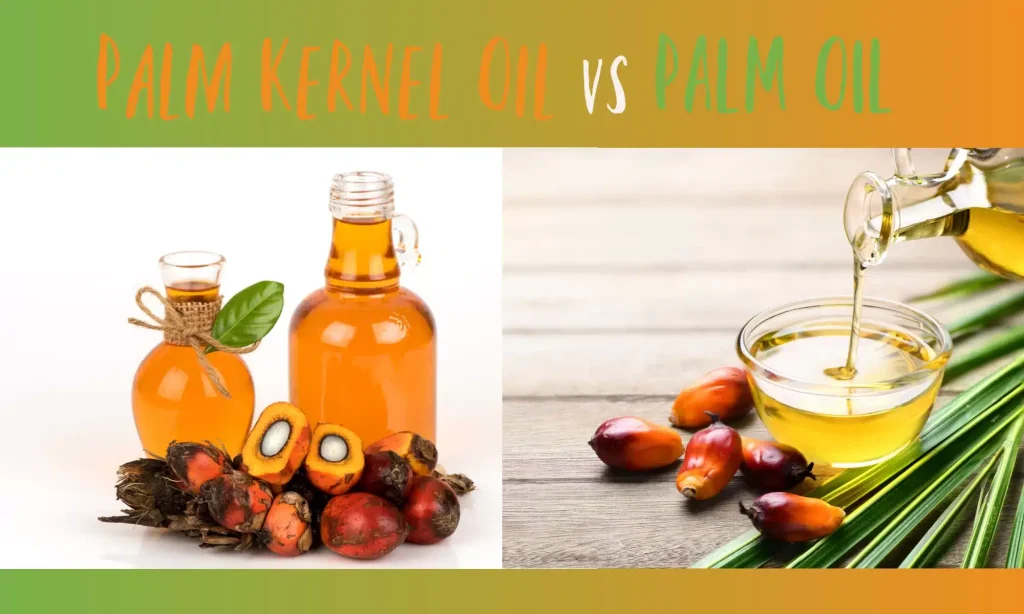The oil palm tree produces palm oil and palm kernel oil, both widely used in industries such as food, cosmetics, biofuels, and more.Despite sharing a common ancestor, they differ in their traits, methods of manufacturing, and applications. This article explores their differences in extraction, composition, nutrition, applications, and environmental impact.
What is Palm Oil?
Palm oil, a type of vegetable oil, is derived from the fleshy part (mesocarp) of the oil palm tree’s fruit. The oil is rich in saturated and unsaturated fats, and its color can range from golden yellow to reddish-orange due to the presence of carotenoids like beta-carotene.
One of the most adaptable oils in the food business, palm oil is utilized as a component in processed foods, baked goods, snack foods, cooking oils, and margarine. Non-food items, including soaps, detergents, cosmetics, and biodiesel also include it. The high output per hectare of palm oil, which makes it more economical and efficient than other vegetable oils like soybean or sunflower oil, is one of the factors contributing to its widespread use.
What is Palm Kernel Oil?
In contrast, palm kernel oil is derived from the oil palm fruit’s kernel or seed. Palm kernel oil is derived from the hard, nut-like seed that is inside the fruit, whereas palm oil is produced from the soft mesocarp. The extraction of palm kernel oil differs from that of palm oil; in order to remove the oil from the kernels, mechanical or solvent extraction techniques are needed.
Palm kernel oil is solid at room temperature and has a higher content of saturated fats, including lauric acid. It is used in similar products to palm oil, such as in cooking, confectionery, and cosmetics. However, due to its specific fatty acid composition, palm kernel oil is preferred for certain industrial applications like soap production and as an ingredient in personal care products.

Extraction Process
The extraction methods for palm oil and palm kernel oil are similar in that both involve mechanical and sometimes chemical processes to extract oil from the fruit. However, the techniques and the part of the palm fruit used differ.
Palm Oil Extraction Process
- Fruit Harvesting: The oil palm tree is used to gather fresh fruit bunches (FFB).
- Sterilization: The fruit is then steamed or sterilized to soften the fruit and make the oil extraction easier.
- Threshing: The fruit is separated from the bunches by a threshing machine.
- Pressing: The oil is extracted by pressing the fruit through mechanical methods or by using hydraulic presses.
- Clarification and Filtration: The extracted oil is clarified to remove impurities, water, and solids, resulting in crude palm oil.
Palm Kernel Oil Extraction Process
- Crushing the Kernels: After the palm fruit is processed for palm oil, the remaining kernels (seeds) are separated and crushed to extract the oil.
- Pressing: To extract the oil, the crushed kernels are mechanically pressed. Solvents may be utilized in certain situations to optimize the extraction of oil.
- Refinement: To create crude palm kernel oil, the oil is further processed to eliminate contaminants.
Fatty Acid Composition and Nutritional Content
Both palm oil and palm kernel oil have high levels of saturated fats, but they differ in their fatty acid profiles, making them suitable for different uses in the food and industrial sectors.
Composition of Palm Oil
About 40% of palm oil is unsaturated fat, 10% is polyunsaturated fat, and 50% is saturated fat. The main fatty acids in palm oil include:
- Palmitic Acid (C16:0): This saturated fat is the predominant fatty acid in palm oil, comprising around 40% of its total fatty acids.
- Oleic Acid (C18:1): A monounsaturated fat, oleic acid makes up about 40% of palm oil. Higher concentrations of this heart-healthy fatty acid can be found in olive oil.
- Linoleic Acid (C18:2): A polyunsaturated fat, linoleic acid is present in smaller quantities.
Vitamin E (tocopherols and tocotrienols), which have antioxidant properties, and carotenoids, especially beta-carotene, are also abundant in palm oil.
Properties of Palm Kernel Oil
Saturated fats are more prevalent in palm kernel oil than in palm oil. The main fatty acids in palm kernel oil include:
- Lauric Acid (C12:0): Lauric acid is the primary fatty acid in palm kernel oil, comprising about 45-55% of the total fatty acid content. The antiviral and bactericidal qualities of this medium-chain fatty acid are widely recognized.
- Myristic Acid (C14:0): Another saturated fat present in palm kernel oil, making up about 16-18% of its fatty acid content.
- Oleic Acid (C18:1): Like palm oil, palm kernel oil contains oleic acid, but in much lower amounts.
Palm kernel oil also contains significant levels of antioxidants like vitamin E, but has fewer carotenoids compared to palm oil. The higher level of lauric acid in palm kernel oil gives it unique functional properties, especially in soap-making and cosmetics.
Applications of Palm Oil and Palm Kernel Oil
While both palm oil and palm kernel oil are used in food, personal care, and industrial products, their applications differ due to their distinct fatty acid compositions.
Applications of Palm Oil
- Cooking and Food Production: Palm oil is widely used in frying and cooking because of its high smoke point and stability. It is a component of shortening, margarine, cooking oils, and processed goods like biscuits, snacks, and prepared meals.
- Cosmetics and Personal Care: Because of its moisturizing qualities, palm oil is utilized in shampoos, lotions, soaps, and cosmetics. It is also used as a base for many personal care products.
- Biofuels: Palm oil is used in biodiesel production due to its availability and high oil content.
- Industrial Applications: Palm oil is used in the production of oleochemicals, such as fatty acids, which are then used in surfactants, detergents, and lubricants.
Applications of Palm Kernel Oil
- Soap and Detergent Production: Palm kernel oil’s high lauric acid content makes it ideal for soap-making. The oil produces a hard, long-lasting bar soap and is often used in personal care products.
- Cosmetics: Palm kernel oil is used in cosmetics and personal care products such as shampoos, conditioners, and moisturizers due to its rich content of lauric acid, which helps to nourish and cleanse the skin.
- Applications in Industry: Fatty acids, which are subsequently utilized in a variety of industrial goods including lubricants and polymers, are also produced from palm kernel oil.
The effects of palm oil and palm kernel oil on the environment
Both palm oil and palm kernel oil have raised environmental concerns due to the large-scale deforestation and habitat destruction caused by the expansion of oil palm plantations. Indonesia and Malaysia are the largest producers of both palm oil and palm kernel oil, and their palm oil industries have been linked to significant environmental issues such as deforestation, loss of biodiversity, and greenhouse gas emissions.
However, with groups like the Roundtable on Sustainable Palm Oil (RSPO) promoting ethical production methods, palm oil production has been moving closer to sustainability. Sustainable palm oil production aims to mitigate environmental harm by ensuring that plantations are not established on ecologically sensitive lands, reducing emissions, and promoting better labor practices.
Both palm oil and palm kernel oil are impacted by these sustainability efforts, and the industry is working to make improvements in supply chains to ensure that the oils are produced in an environmentally friendly manner.
Health Considerations
Both palm oil and palm kernel oil have high levels of saturated fats, which can raise concerns about their impact on heart health. However, the specific types of saturated fats differ between the two oils.
Palm Oil: The presence of oleic acid in palm oil gives it some heart-healthy benefits, as it is a monounsaturated fat that may help reduce cholesterol levels. However, the high palmitic acid content, a saturated fat, has been linked to elevated cholesterol levels when consumed in large quantities.
Palm Kernel Oil: Lauric acid, a medium-chain saturated fat, is more prevalent in palm kernel oil. While some research suggests that medium-chain fats may have less of an adverse effect on cholesterol levels, palm kernel oil is still high in saturated fat and should be consumed in moderation.
Conclusion
In conclusion, palm oil and palm kernel oil, though from the same tree, differ in composition, extraction, uses, and environmental impact. Palm oil is used for cooking and food processing, while palm kernel oil is found in soaps, cosmetics, and confectionery. Both oils are versatile but have distinct fatty acid profiles.
As demand increases, greater attention is being paid to the environmental effects of the palm oil industry. Efforts to promote sustainable production are underway, but challenges remain regarding sustainability and health.


